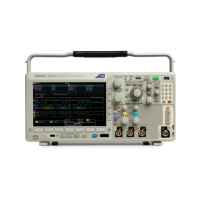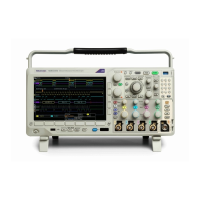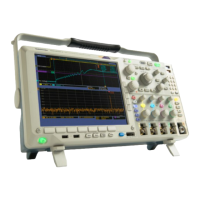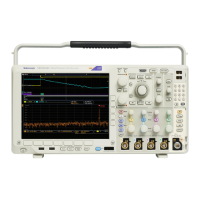Performance Ver
ification
16. A djust the signal source to the maximum bandwidth frequency for the bandwidth and model desired, as shown in the
following work
sheet. Measure V
p-p
of the signal on the oscilloscope using statistics, as in the previous step, to get the
mean V
p-p
. Call this reading V
bw-pp
.
Record the value of V
bw-pp
in the test record.
NOTE. For more information on the contents of this worksheet, refer to the Analog Channel Input and Vertical Specifications
table. (See p
age 1, Analog Channel Input And Vertical Specifications.)
Table 41: Maximum Bandwidth Frequency worksheet
Ter m in atio
n
Vertical Sc
ale
Maximum Ban
dwidth Frequency
For instrumen ts with 1 GHz bandwidth
(includes
MDO310X models as well as MDO305X/303X/302X/301X models with 1 GHz upgrade):
50 Ω 10 mV/div 1 GHz
50 Ω 5 mV/div 500 MHz
50 Ω 2 mV/div 350 MHz
50 Ω 1 mV/div 150 MHz
For ins
truments with 500 MHz bandwidth
(includes MDO305X models as well as MDO 303X/302X/301X models with 500 MHz upgrade):
50 5mV/d
iv
500 MHz
50 2 mV/div
350 MHz
50 1 mV/div
150 M
Hz
For instruments with 350 MHz b andwidth
(inc
ludes MDO303X models as well as MDO302X/301X models with 350 MHz upgrade):
50 5 mV/div
350 MHz
50 2 mV/div
350
MHz
50
1m
V/div
150 MHz
For instruments with 200 MHz b andwidth
(includes MDO302X models as well as MDO301X models with 200 MHz upgrade):
50 Ω 2 mV/div 200 MHz
50
Ω
1m
V/div
15
0MHz
For instruments with 100 MHz b andwidth
(MDO301X m odels):
50 1 mV/div
1
00 MHz
17. Use the values of V
bw-pp
andV
in-pp
obtained above and stored in the test record to calculate the Gain at bandwidth
with the following equation:
Gain = V
bw-pp
/V
in-pp
.
18. To pass the performance measurement test, Gain should be 0.707. Enter Gain in the test record.
MDO3000 Series S pecifications and Performance Verification 77

